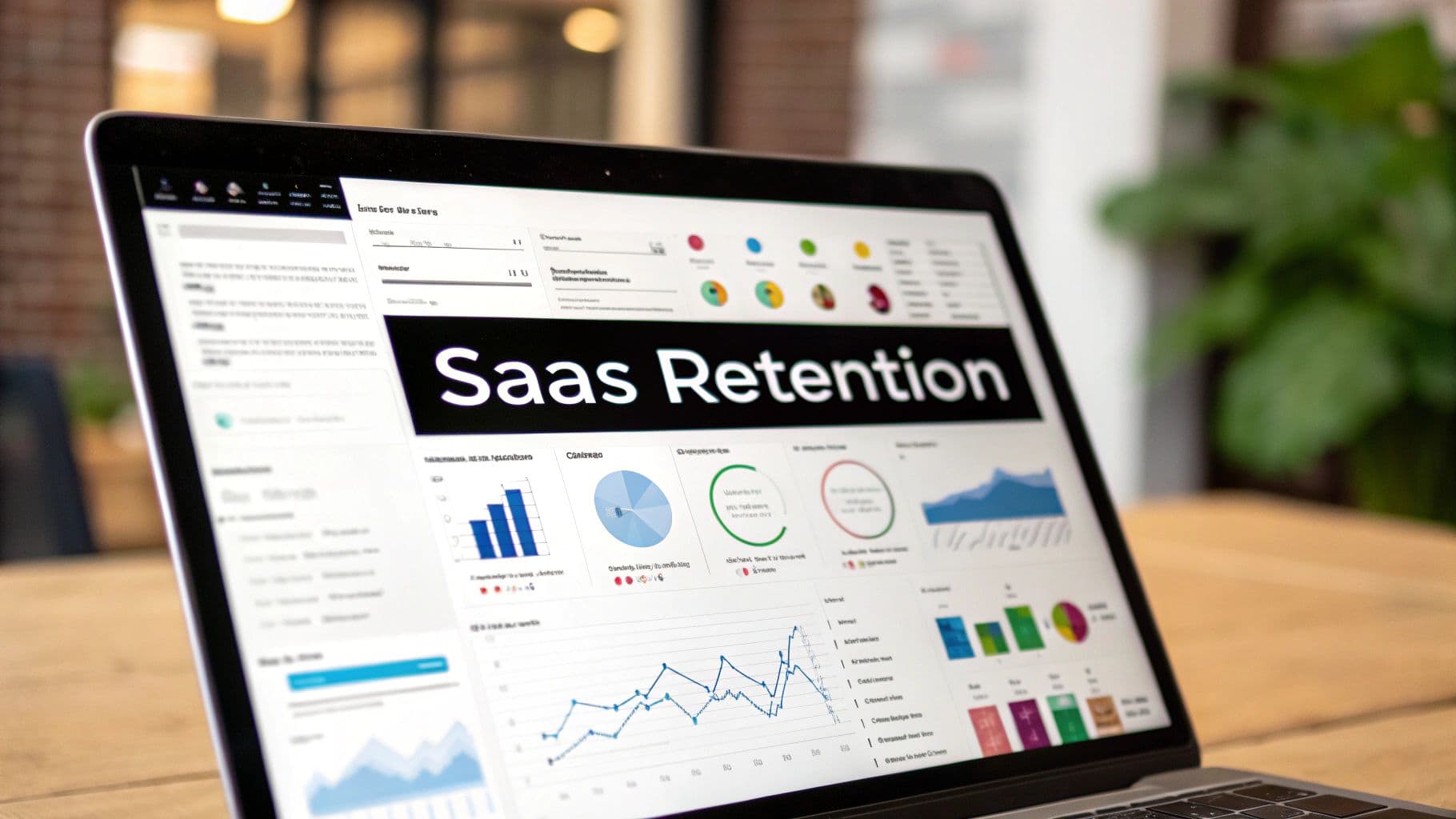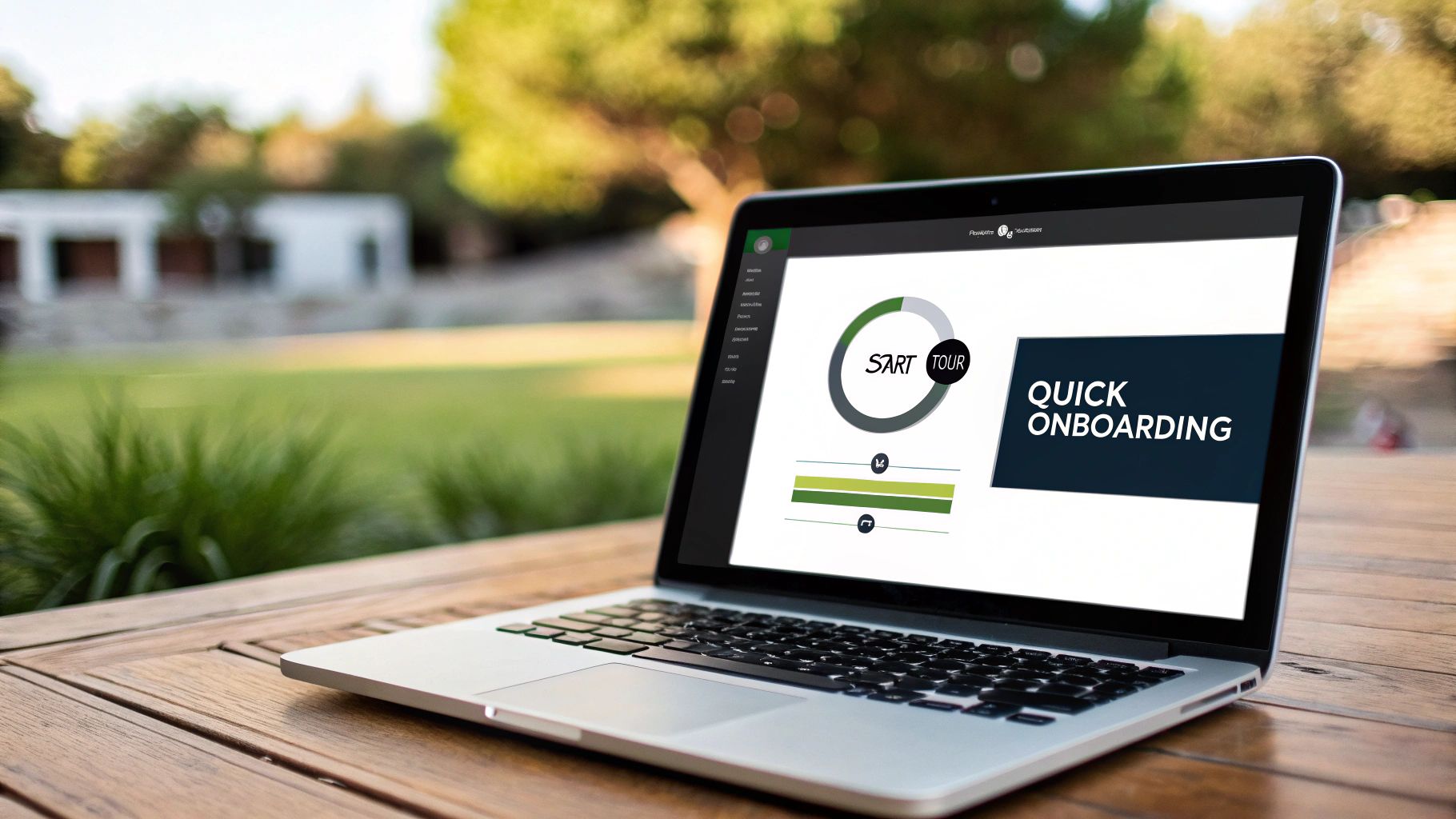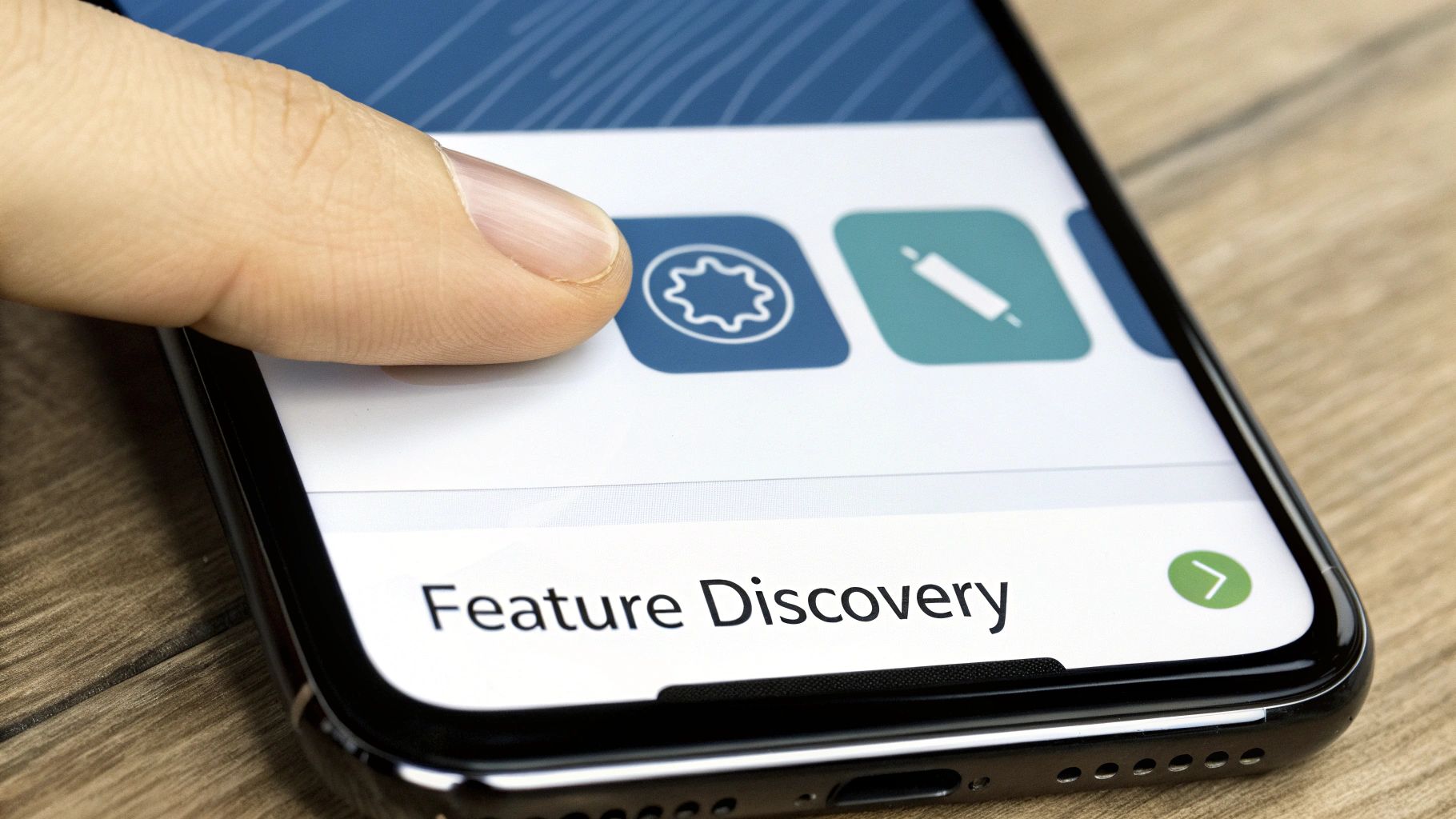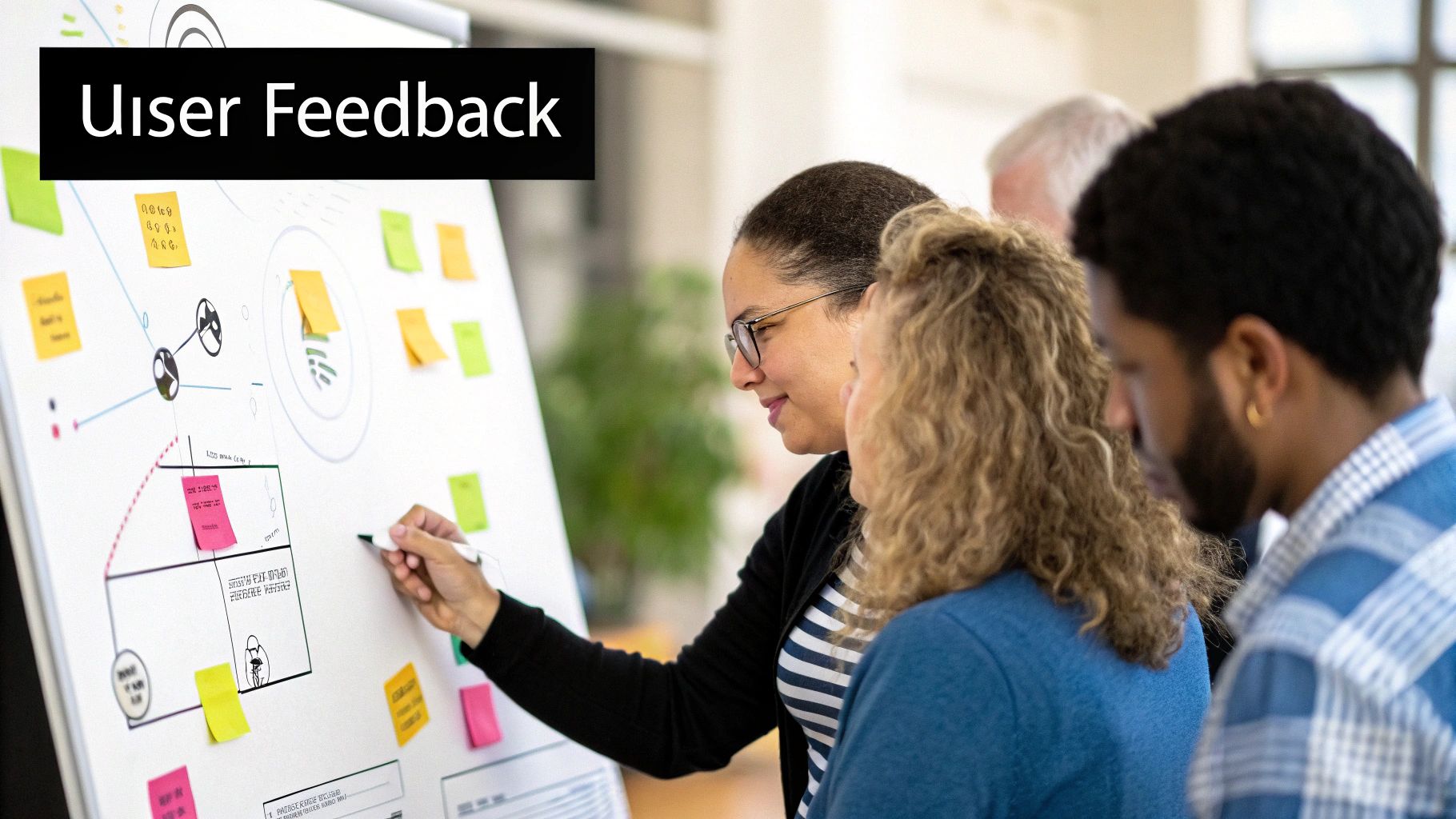
7 Proven SaaS Customer Retention Strategies for 2025
In the competitive SaaS landscape, acquiring new customers is only half the battle. True, sustainable growth is built on the foundation of retaining the customers you already have. High churn rates can silently sink even the most promising ventures, making customer retention not just a priority, but the central pillar of long-term success. But where do you start when old, generic advice no longer cuts it?
This article moves beyond the obvious to provide a deep dive into seven powerful, actionable SaaS customer retention strategies that modern, high-growth companies use to build unshakable loyalty and maximize lifetime value. We will explore how to create a customer journey that fosters loyalty from the very first interaction. Ensuring this journey is accessible to all users is also a critical, yet often overlooked, component of retention. Implementing essential website accessibility best practices ensures your SaaS product caters to the broadest possible audience, minimizing potential churn due to usability issues.
From a flawless onboarding experience that delivers immediate value to sophisticated health scoring that predicts and prevents churn, we'll break down each strategy with practical examples, key metrics, and implementation tips you can use today. This isn't a theoretical overview; it's a practical playbook for reducing churn and turning satisfied customers into dedicated advocates for your brand. Forget surface-level tips. Prepare to explore proactive success management, value-based communication, and pricing models that align your success directly with your customers' growth. Let’s dive into the strategies that will define sustainable SaaS growth.
1. Proactive Customer Onboarding
The single most critical phase for customer retention happens right at the beginning. Proactive customer onboarding is a structured, interactive process that guides new users to their first "Aha!" moment as quickly as possible. This strategy focuses on reducing the time-to-value by helping customers achieve a meaningful outcome, which solidifies their decision to stick with your product long-term.

Unlike a passive product tour that simply points out features, a proactive approach is goal-oriented. It anticipates user needs and removes friction before it causes frustration. The core philosophy, popularized by customer success leaders like Lincoln Murphy and Samuel Hulick, is that customers don't churn because of a missing feature; they churn because they failed to achieve their desired outcome. Effective onboarding ensures they succeed from day one.
How It Works in Practice
Leading SaaS companies use proactive onboarding to make an immediate impact. Asana, for example, offers role-based onboarding that customizes the initial experience for a project manager versus a team member, showing each user the most relevant features first. Similarly, Canva’s interactive tutorials guide you to create your first design within minutes of signing up, delivering immediate, tangible value.
This method is one of the most powerful SaaS customer retention strategies because it directly counters early-stage churn. By setting customers up for success, you build confidence and demonstrate your product's value proposition before the first invoice is even sent. To lay a strong foundation for these long-term customer relationships, consider these essential customer onboarding best practices that boost retention and success.
Actionable Tips for Implementation
- Focus on the "Quick Win": Design the first session around achieving one specific, valuable outcome rather than overwhelming users with a comprehensive feature tour.
- Use Progressive Disclosure: Introduce advanced features gradually as users become more proficient. Don't show them everything at once.
- Gamify the Process: Implement onboarding checklists with progress bars or completion percentages to motivate users to explore key functionalities.
- Segment Your Onboarding: Create different onboarding paths based on customer segment, use case, or job role. A small business owner needs a different introduction than an enterprise-level team lead.
- Leverage Behavior-Triggered Communication: Send automated emails or in-app messages when users get stuck on a step or haven't completed a key action after a certain period.
2. Customer Health Scoring
Customer health scoring is a data-driven methodology that proactively predicts customer loyalty or churn risk. It works by assigning a quantitative score to each customer account based on a variety of engagement, usage, and satisfaction metrics. This score acts as an early warning system, allowing customer success teams to identify at-risk accounts and prioritize interventions before problems escalate.

This strategy moves teams from a reactive "firefighting" model to a proactive, predictive one. The core philosophy, championed by customer success platforms like Gainsight and ChurnZero, is that customer behavior tells a story. By analyzing key signals, a business can understand which customers are deriving value and are on a path to renewal, and which are disengaging and quietly heading for the exit.
How It Works in Practice
Leading SaaS companies use customer health scores to manage their portfolios at scale. Gainsight, a pioneer in this space, helps companies like Zoom and Okta aggregate product usage data, support tickets, and survey responses into a single, actionable score. Similarly, Intercom uses its own health scores to trigger automated, targeted re-engagement campaigns or assign high-risk accounts directly to a customer success manager (CSM) for personal outreach.
This approach is one of the most effective saas customer retention strategies because it makes customer success scalable and data-informed. Instead of treating all customers equally, you can focus your most valuable resources on the accounts that need them most. ChurnZero, for example, enabled clients like Jobvite to use real-time health scores to drive CSM activities, helping them achieve retention rates of over 95%.
Actionable Tips for Implementation
- Start with 3-5 Key Indicators: Don't try to track everything at once. Begin with a focused set of metrics like login frequency, breadth of feature adoption, number of support tickets, and NPS scores.
- Weight Product Usage Heavily: For B2B SaaS, how customers use your product is the strongest predictor of retention. Give product usage metrics a higher weight in your scoring model than demographic data.
- Combine Leading and Lagging Indicators: Include lagging indicators (past behavior like survey results) and leading indicators (predictive signals like a drop in daily active users) for a more accurate picture.
- Create Segment-Specific Models: A startup's health profile looks different from an enterprise client's. Develop different scoring models for different customer segments or product tiers.
- Review and Recalibrate Quarterly: Your product and customer base evolve. Review your health scoring model every quarter against actual churn data to ensure it remains accurate and predictive.
- Automate Proactive Workflows: Set up automated actions based on score changes. For example, a significant drop in a health score could trigger an alert to the assigned CSM and enroll the customer in a re-engagement email sequence.
3. In-App Engagement and Feature Adoption Programs
Beyond initial onboarding, retaining customers requires a continuous effort to demonstrate value. In-app engagement and feature adoption programs are strategic initiatives that guide existing customers to discover, adopt, and benefit from functionalities they may not be using. This approach recognizes a critical truth: customers who integrate more features into their workflow have significantly higher retention rates because the product becomes indispensable to their success.

This strategy moves beyond passive availability, actively promoting features within the user's context. The philosophy, championed by growth leaders like Chamath Palihapitiya and product experts like Nir Eyal, is that habit formation is key to retention. When users build routines around multiple features, the product becomes deeply embedded, making churn a much less likely outcome. It's about transforming a single-use tool into a multi-faceted solution.
How It Works in Practice
Top-tier SaaS companies excel at driving feature adoption. For instance, Spotify’s "Discover Weekly" playlist wasn't just a new feature; it was an engagement engine that used user data to deliver personalized value, driving repeat usage. Similarly, Dropbox prompts users who upload multiple files to share the folder, contextually introducing a core collaborative feature at the exact moment of need. Grammarly also uses this tactic by showing contextual prompts for premium features when a user's writing could benefit from them.
This method is one of the most effective SaaS customer retention strategies because it directly fights feature blindness and user stagnation. By continuously revealing new layers of value, you prevent the product from feeling stale and increase its perceived worth over time. These programs ensure that as a customer's needs evolve, your product evolves with them, solidifying the long-term partnership.
Actionable Tips for Implementation
- Map Features to Goals: Don't just promote features; promote outcomes. Connect each underutilized feature to a specific customer pain point or goal and frame your in-app message around solving that problem.
- Use a Contextual Framework: Apply the 'right person, right time, right message' model. Trigger feature spotlights based on user behavior, not on a generic schedule.
- Track "Breadth of Usage": Monitor how many distinct features a user or account engages with regularly. This metric is a powerful leading indicator of account health and potential churn risk.
- Implement "Feature Spotlight" Campaigns: Create short, targeted in-app tours, tooltips, or email campaigns that highlight one underused feature per month, explaining its benefits and use cases.
- Celebrate Adoption: Use positive reinforcement. When a user tries a new feature for the first time, greet them with a congratulatory message or a simple animation to acknowledge their progress and encourage continued exploration.
4. Proactive Customer Success Management
Proactive Customer Success Management moves beyond reactive support to create long-term partnerships. This strategic approach involves dedicated Customer Success Managers (CSMs) who regularly engage with accounts to ensure customers achieve their desired outcomes, anticipate needs, and maximize the value they get from your product. It’s about building a relationship, not just closing a ticket.

Unlike a reactive model that waits for customers to report problems, a proactive approach focuses on delivering value consistently throughout the customer lifecycle. The core philosophy, popularized by thinkers like Lincoln Murphy and codified by platforms such as Gainsight and ChurnZero, is that customer success is a company-wide initiative. It aims to make your customer so successful with your product that they can’t imagine their business without it.
How It Works in Practice
Leading SaaS companies have institutionalized proactive customer success to drive exceptional retention. For instance, Adobe’s transition to the Creative Cloud was supported by a robust CSM program that helped secure over 95% enterprise retention. Similarly, Workday assigns dedicated success managers to all its customers, a key factor in its industry-leading net retention rates. ServiceNow’s focused Customer Success organization has helped the company consistently achieve a dollar-based net retention rate above 120%, showcasing the power of this strategy.
This method is one of the most effective SaaS customer retention strategies because it transforms the vendor-customer dynamic from transactional to strategic. By aligning your success with your customer's success, you create a powerful incentive for them to stay and grow with you. CSMs act as strategic advisors, ensuring the product continuously solves real business problems and delivering measurable ROI.
Actionable Tips for Implementation
- Segment Your Customer Base: Implement a tiered model. High-touch accounts get a dedicated CSM, mid-tier accounts receive low-touch (tech-enabled) management, and smaller accounts are managed via a tech-touch-only model.
- Develop Standardized Success Plans: Create playbooks for common scenarios like onboarding, renewal, and at-risk accounts. These plans should include key milestones and desired outcomes but be customizable for each client.
- Train CSMs as Consultants: Equip your CSMs with business consulting skills, not just deep product knowledge. They need to understand the customer’s industry, challenges, and strategic goals.
- Conduct Quarterly Business Reviews (QBRs): Use QBRs to demonstrate the tangible value and ROI delivered, focusing on business outcomes rather than just product usage metrics.
- Build Executive Relationships: Ensure CSMs cultivate relationships with executive sponsors at key accounts, not just the day-to-day users. This builds strategic alignment and protects against churn if a key contact leaves.
5. Value-Based Communication and Education
Customer retention often hinges on whether users feel they are continuously gaining value from your product. A value-based communication and education strategy shifts the focus from simple product updates to a continuous stream of strategic insights, best practices, and industry expertise. This approach positions your SaaS company as a trusted advisor, not just a software vendor, making your platform indispensable to your customers' success.
Unlike generic marketing newsletters, value-based education is designed to help customers master your product and their broader business challenges. The philosophy, championed by inbound marketing pioneers like HubSpot's Brian Halligan and Dharmesh Shah, is that an educated customer is an empowered and loyal one. When users understand how to leverage your tool to its fullest potential, they achieve better outcomes, see a clearer ROI, and are far less likely to churn.
How It Works in Practice
Leading SaaS companies have built entire ecosystems around this strategy. HubSpot Academy, for example, offers free certification courses that have not only trained hundreds of thousands of professionals but also created a massive community of product advocates. Similarly, Salesforce’s Trailhead is a gamified learning platform that turns complex CRM concepts into engaging, accessible modules, fostering deep loyalty and user proficiency.
This method is one of the most effective SaaS customer retention strategies because it builds a moat of expertise around your product. By helping customers become better at their jobs, you create a powerful dependency that competitors cannot easily replicate. For businesses managing subscriptions, this continuous value demonstration is critical for justifying ongoing costs and ensuring smooth transactions, which is why it's vital to understand how to set up recurring payments to support these long-term relationships.
Actionable Tips for Implementation
- Create a Centralized Education Hub: Build a dedicated academy, resource center, or knowledge base rather than scattering educational content across blogs and emails.
- Segment and Personalize Content: Tailor your educational materials based on user role, industry, and maturity level. An admin needs different training than a new end-user.
- Send Regular 'Value Reports': Automate monthly or quarterly emails that showcase the specific ROI a customer has achieved, using their own data and metrics to prove value.
- Host Customer-Led Webinars: Feature your most successful customers as case studies, allowing them to share their strategies and best practices with their peers. This provides social proof and actionable advice.
- Develop Different Content Tracks: Structure your learning paths for beginner, intermediate, and advanced users to ensure there is always something new for customers to learn as they grow.
6. Customer Feedback Loops and Co-Creation
This strategy transforms the traditional customer relationship into a collaborative partnership. A customer feedback loop is a systematic process of gathering, analyzing, and acting on customer input, then communicating the results back to them. It positions customers as active co-creators in your product's evolution, fostering deep loyalty by making them feel heard and invested in your mutual success.
Unlike passively collecting suggestions in a forgotten inbox, this approach is a dynamic, continuous cycle. The core philosophy, championed by innovators like Rahul Vohra of Superhuman and Jason Fried of Basecamp, is that the most valuable product insights come directly from the people using it every day. By treating feedback not as criticism but as a roadmap, you build a product that customers genuinely need and refuse to leave.
How It Works in Practice
Leading SaaS companies use co-creation to build unbreakable customer bonds. Atlassian’s public issue tracker, for instance, allows users to submit, vote on, and track the progress of feature requests, creating radical transparency. Similarly, Figma’s community forums and public beta program involved designers directly in the product's development, making them feel like true partners and fueling viral adoption through word-of-mouth.
This method is one of the most effective SaaS customer retention strategies because it builds an emotional connection that transcends features and pricing. When customers see their feedback implemented, they feel a sense of ownership and validation. This process turns your user base into a loyal community that not only stays with you but actively advocates for your brand.
Actionable Tips for Implementation
- Close the Loop: Always follow up with customers who provide feedback. Let them know if you're building their suggestion, and if not, transparently explain why.
- Mix Quantitative and Qualitative Data: Use surveys like NPS and CSAT to measure sentiment, but pair them with in-depth qualitative interviews to understand the "why" behind the numbers.
- Create Tiered Feedback Channels: Implement public forums for general ideas, but create exclusive customer advisory boards for key accounts to provide strategic input on your roadmap.
- Use the "Jobs to Be Done" Framework: When analyzing feature requests, dig deeper to understand the underlying problem or "job" the customer is trying to accomplish. This prevents you from building superficial solutions.
- Publicly Credit Your Co-Creators: When you launch a feature based on customer feedback, give those customers a public shout-out on social media or in your release notes.
7. Usage-Based Pricing and Flexible Plans
A pricing model that directly ties cost to value is one of the most powerful SaaS customer retention strategies available. Usage-based pricing (UBP) aligns what a customer pays with the actual value they receive, allowing them to scale spend up or down based on consumption. This strategy dismantles the 'pay-for-what-you-don't-use' problem, a common source of churn in rigid, fixed-tier subscription models.
Instead of locking customers into high-commitment contracts, this flexible approach builds retention through fairness and shared success. The core philosophy, championed by pricing experts like Patrick Campbell and venture firms like OpenView Partners, is that when your revenue grows only as your customers succeed and use your product more, your incentives are perfectly aligned. This creates a natural, low-friction path for expansion and a high barrier to churn.
How It Works in Practice
Pioneers of this model have demonstrated its incredible retention power. AWS built its empire on pay-as-you-go cloud services, allowing startups to scale from a few dollars to millions in monthly spend without ever renegotiating. Snowflake, a data cloud company, uses a consumption model that contributed to its staggering 168% net revenue retention rate, as its revenue grows lock-step with its customers' data volume.
Similarly, Twilio’s API-first, pay-as-you-go pricing for communications removed commitment barriers for developers, while Stripe’s per-transaction fee ensures it only makes money when its merchants do. This approach is a powerful retention tool because it makes the decision to stay easy; customers pay for tangible value, not shelfware. To see how this compares to other models, you can explore these subscription business model examples and find the best fit for your product.
Actionable Tips for Implementation
- Choose a Value Metric: Tie your pricing to a metric that directly reflects the value customers get from your product, such as API calls, data stored, or messages sent.
- Offer Hybrid Models: Provide multiple pricing options, like a base subscription fee plus usage-based overages, to cater to customers who prefer predictability.
- Prevent Bill Shock: Implement transparent usage dashboards, spending alerts, and optional hard caps to help customers monitor and control their costs, building trust.
- Design for Expansion: Create pricing tiers that encourage more usage without creating steep "cliffs" where a small increase in usage leads to a massive price jump.
- Allow Easy Downgrades: Make it simple for customers to scale down their usage and costs without needing to contact support, which reduces friction during leaner periods and makes them more likely to stay.
7 Key SaaS Retention Strategies Comparison
| Item | Implementation Complexity 🔄 | Resource Requirements 🔄 | Expected Outcomes ⭐📊 | Ideal Use Cases 💡 | Key Advantages ⚡⭐ |
|---|---|---|---|---|---|
| Proactive Customer Onboarding | High - content creation, tooling, team | Significant - onboarding specialists, tools | Faster time-to-value, reduced early churn | New users needing guided product setup | Scalable personalization, increases adoption |
| Customer Health Scoring | High - data integration, model calibration | Significant - data infrastructure, analytics | Proactive churn prediction, focused success | Large customer base, risk management | Objective prioritization, early intervention |
| In-App Engagement & Feature Adoption | Moderate - analytics, in-app messaging | Moderate - analytics tools, content creation | Increased feature usage, higher retention | Driving deeper product usage | Boosts stickiness, upsell opportunities |
| Proactive Customer Success Management | Very high - skilled CSMs, strategic plans | High - dedicated CSMs, training | Strong relationships, improved retention | High-value, enterprise or strategic accounts | High loyalty, business growth through trust |
| Value-Based Communication & Education | Moderate - ongoing content development | Moderate - content team, platforms | Increased product proficiency, brand loyalty | Broad customer base seeking self-service | Scalable, positions as thought leader |
| Customer Feedback Loops & Co-Creation | Moderate - feedback systems, analysis | Moderate - feedback management resources | Increased loyalty, product relevance | Customer-centric, product evolution focus | Stronger customer investment, better product fit |
| Usage-Based Pricing & Flexible Plans | High - billing system, metering | High - billing infrastructure, monitoring | Revenue alignment, reduced churn | Products needing flexible billing | Fair pricing, natural expansion, appeals to cost-conscious |
From Strategy to Action: Building Your Retention Flywheel
Navigating the landscape of SaaS customer retention strategies can feel overwhelming, but the journey from theory to tangible results begins with a single, focused step. We've explored seven powerful, interconnected pillars designed to transform your customer lifecycle: from the critical first impression of Proactive Customer Onboarding to the financial alignment of Usage-Based Pricing. Each strategy serves as a critical cog in a larger machine, a system designed not just to prevent churn, but to actively cultivate loyalty and advocacy.
The common thread weaving through these tactics is a fundamental shift in perspective. Retention isn't about saving accounts at the last minute; it's about continuously delivering and demonstrating value at every single touchpoint. It's the difference between a reactive support ticket and a proactive check-in from a Customer Success Manager, or the gap between a generic newsletter and a personalized, value-based educational campaign. By implementing systems like Customer Health Scoring and fostering In-App Engagement, you move from guessing what customers need to knowing what they need, often before they do.
Weaving the Strategies into a Cohesive System
True mastery of customer retention comes when these individual strategies begin to influence one another, creating a self-reinforcing cycle of success. Think of it as a flywheel:
- Effective onboarding leads to higher initial feature adoption.
- Higher adoption and engagement improve customer health scores.
- Healthy customers provide more insightful feedback through feedback loops, allowing you to co-create a better product.
- A better product, communicated through value-based education, encourages users to explore more advanced features or upgrade to flexible, usage-based plans.
This interconnectedness means you don't have to implement everything at once. The key is to start where the friction is greatest. Is your initial drop-off rate high? Double down on your onboarding flow. Are users ignoring your most valuable features? It’s time to build a targeted engagement program. By choosing one or two of these SaaS customer retention strategies as your starting point, you can build momentum that makes implementing the next one easier and more impactful.
Your Actionable Path Forward
To translate this knowledge into action, begin with a simple audit. Map your current customer journey and identify the primary point where value is either misunderstood or lost. Is it during the first 48 hours, the first billing cycle, or three months in when initial enthusiasm wanes?
Once you've identified your biggest leak, apply the relevant strategy from this guide as your patch. For instance, if data shows a significant drop-off before the first renewal, the problem could lie in a failure to demonstrate ongoing value. Your immediate focus should be on proactive success management and value-based communication, proving that your platform is an indispensable part of their workflow. A crucial, yet often overlooked, component of this experience is the payment process itself. A failed payment or a confusing billing interface can instantly sour an otherwise positive relationship, directly causing involuntary churn. Ensuring this final, critical step is seamless is non-negotiable for long-term retention.
Ultimately, the goal is to build a business where customer success and your success are one and the same. When your customers win by using your product, you win. This symbiotic relationship is the foundation of a durable, high-growth SaaS company, turning your customer base from a list of subscribers into your most powerful and passionate engine for growth.
A seamless payment experience is a cornerstone of customer retention, preventing the involuntary churn that undermines all your other efforts. BlockBee provides a robust, developer-friendly Crypto Payments API that integrates directly into your SaaS platform, ensuring billing is never a point of friction. Explore how BlockBee can help you secure your revenue and retain more customers.
